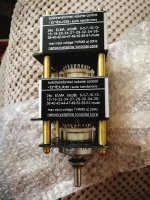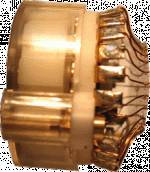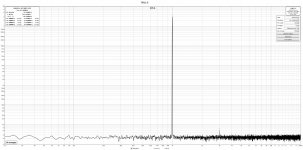Yes I've had it for a while but its a €1500-2000 build and I've had so many "holes" I needed to take care of this year.
First of all I need to build the preamp, so when the opportunity is given, that is the project I will start with.
First of all I need to build the preamp, so when the opportunity is given, that is the project I will start with.
Some update is in order. I have officially paused the project in favor of another preamp. Yes, I am cheating and life give your surprises. The amp in question is the Vacuum State Electronics RTP3D. I am currently working on some of the features and upgrades this amp will have.
But I am not getting rid of the UGS MUSES boards, they might end up in a Purifi class D integrated amplifier one day.
Oneminde
But I am not getting rid of the UGS MUSES boards, they might end up in a Purifi class D integrated amplifier one day.
Oneminde
To bump the discussion I would like express my interest in using these boards for the Purifi buffer, so please keep this alive and let me know if I can be any help!
Dear PKI and everyone else reading, this project has been dead for quite a while in favour for the least destructive volume attenuation known to man, and that is Magnetic Volume Attenuation as opposed to Resistive based. I started this thread long before I knew and understood the difference in technology and how much or little it affects the signal, so with that in mind, after I learned the the concepts of magnetic attenuation, I had to change my approach.To bump the discussion I would like express my interest in using these boards for the Purifi buffer, so please keep this alive and let me know if I can be any help!
My MUSES preamp will likely sit in its box and collect dust, but that is okay for not every project is meant to pan out 😉
Sowter uses EI cores to my knowledge and they are inferior to toroidal cores (B-field and stray field related), so there is probably some to be had by simply switching the core and configuration used. But... I don't know how you hear things, so I can only speculate. But If you preferer the MUSES then that is sort of it. Another friend compared the MUSES against a differential tube pre and liked the tube one better.I Just replaced my Sowter transformer volume control with a preamp that uses the MUSES volume control. My ears say the MUSES preamp is better.
EI cores are not principally inferior to toroidal cores. Yes, toroids tend to be immune tot external fields. However, they also tend to saturate quite quickly with just a tiny little bit of DC.Sowter uses EI cores to my knowledge and they are inferior to toroidal cores (B-field and stray field related), so there is probably some to be had by simply switching the core and configuration used.
I am referring to the passive stepped resistor attenuator inside the MUSES chip (not the opamp which may also be inside the same chip). Comparing the passive attenuator to an amplifier does not make much sense to me.Another friend compared the MUSES against a differential tube pre and liked the tube one better.
Sure, but you are listening to the whole chip and any "modification" taking place, which was what I referred to. I am not saying the MUSES attenuator is a bad choice, not at all. It sits on the highest shelf when it comes to those type of products 🙂. And to expand my comment, the better was also a reference to tubes sounding better than IC's for the listener.I am referring to the passive stepped resistor attenuator inside the MUSES chip (not the opamp which may also be inside the same chip). Comparing the passive attenuator to an amplifier does not make much sense to me.
When it comes to the whole magnetic vs resistive attenuation, this is down to some very real and tangible differences.
A magnetic volume attenuator transforms the incoming signal via voltage regulation but does not significantly affect the total power. That is to say, watt in equals watt out and very little is lost. So as the voltage is attenuated down, the current increases. That is what a transformer does, it transforms the available power. The effect of attenuating the volume this way is that as the volume goes down or less voltage comes out, the current increases and thus able the micro-details in the recording to be maintained at low(ish) listening levels. In other words, low to no power compression, which is in direct and stark contrast to resistors which are power converters. A resistor takes the incoming power and throw out the unwanted in the form of heat. This affects the whole signal, voltage and current, and thusly, adds power compression at low listening levels or low signal levels. Resistors also suffer from Johnson–Nyquist noise (thermal noise) which are, in the end, physical attribute and differences between magnetic and resistive attenuation.
I think a quick analysis here can tell us two things. 1) The choice of resistor, its technology and accuracy, will translate into a HUGE difference in performance since we are talking about a few hundred mV and mA on average (on the input side of the power amplifier). Any noise here is amplified as we all know. 2) As long as the magnetic core have high saturation, low losses and low amounts of memory, a magnetic attenuator IS the closest thing you can come to the ideal amplifier in spirit.
For in spirit, the magnetic attenuator, as I see it, and as I see it is the toroidal voltage divider, is a copper wire which attenuates the voltage and "store" the current in the core. But not all transformers are made the same, with the same technology, materials etc. Its like saying a horn tweeter with its compression driver will sound the same as a foil or planar magnetic tweeter.
NAGRA use this approach in their preamplifier, a nanocrystalline core and voltage taps situated around the core. See attached images.
To be clear, I did not write this reply to convince you mbrennwa of anything, just offer a productive counter offer. Not everything is created the same or as it seems.
Attachments
Hello Onemide,this project has been dead for quite a while in favour for the least destructive volume attenuation known to man, and that is Magnetic Volume Attenuation
What transformers are you using?
Do you mind sharing some photos with the project? You had a nice idea for the Scion enclosure.
Thank you. Yes that volume wheel was the soul for this project.
I have been too busy to work on the attenuator project, but have collected lots of information and planning how to execute everything. There's also been huge supply restraints as of late, so I need to get some equipment and cores such that I can start winding and testing. That should answer your question regarding which transformers I will use - my own 🙂. I definitely want to make good progress and have good control over the transformers and controller before I start thinking about maybe creating a forum thread. Right now I am not going to say yes to a thread, but if I did, things need to be complete, and there will probably be group sale etc. Stuff like that. So we will see 🙂
I have been too busy to work on the attenuator project, but have collected lots of information and planning how to execute everything. There's also been huge supply restraints as of late, so I need to get some equipment and cores such that I can start winding and testing. That should answer your question regarding which transformers I will use - my own 🙂. I definitely want to make good progress and have good control over the transformers and controller before I start thinking about maybe creating a forum thread. Right now I am not going to say yes to a thread, but if I did, things need to be complete, and there will probably be group sale etc. Stuff like that. So we will see 🙂
Nanocrystalline (Metglas amorphous alloy from Hitachi Metals.)What type of cores do you plan yo use?
Sure, but you are listening to the whole chip...
Uhm, no. Only the stepped tesistor network is connected. The active part (opamp) of the chip is not connected.
Don't get me wrong, I do understand that a resistive attenuator "burns" signal power, while a transformer does not. However, a bunch of resistors a certainly way more linear than a transformer. Also, signal power is hardly relevant, because in a preamp volume control we're only concerned with signal voltage, while currents are virtually zero.
Transformer volume controls are nice for passive line stages, because they provide great impedance matching. Yet, an active preamp/buffer with a resistive volume control can be made with much better linearity than a transformer.
That said, I did like the effect of the Sowter TVC on the sound. The low-prder harmonics can be quite pleasing to the ear. Stll, I prefer the clean, no-nonsense sound I get from my active preamp with MUSES volume control.
I have the MUSES project offered here at diya.com, might even build it one day. I was among the lucky few who got my hands on the PASS gain stage which in essence makes this a PASS preamplifier... should I say in spirit 😉.Stll, I prefer the clean, no-nonsense sound I get from my active preamp with MUSES volume control.
No nonsense among the best. The only one I can think of which according to those who have this one, is or can be better, is the Vacuum State RTP3D (fully differential) which I could also build. That could be an interesting test actually, the MUSES with PASS gain stage VS. Allan's RTP3DWell, I am listening to a Pass preamp with a MUSES volume control... its a fine preamp!
In my ugs preamp I have a cinemag wired as a autotransformer with 6db gain. It was inspired from ZenMod IP.
Both the ugs and the cinemag version sound very good, I can't decide between them.
When fed with low frequency(20-50hz) and high level signals the autotransformer behaves a bit worse than the ugs because the core stars to saturate.
Being able to convert bal/se to bal/se, the sound is good, it is also very simple and most important doesn`t used unobtainable parts so I thought about trying better cores for the autotransformer. I want to try the AMCC016A and wind my own coils like you, 1+1:1+1 for 6db gain exactly like the cinemag(to be able to compare them).
These cores are big but are good if you want to drive a power follower and want low thd at low frequencies. For line levels a smaller core will do.
For me at this moment winding those transformers are only future plans and I need to learn first how to wind them...
What core do you want to use? the amcc 8 or a smaller one?
Both the ugs and the cinemag version sound very good, I can't decide between them.
When fed with low frequency(20-50hz) and high level signals the autotransformer behaves a bit worse than the ugs because the core stars to saturate.
Being able to convert bal/se to bal/se, the sound is good, it is also very simple and most important doesn`t used unobtainable parts so I thought about trying better cores for the autotransformer. I want to try the AMCC016A and wind my own coils like you, 1+1:1+1 for 6db gain exactly like the cinemag(to be able to compare them).
These cores are big but are good if you want to drive a power follower and want low thd at low frequencies. For line levels a smaller core will do.
For me at this moment winding those transformers are only future plans and I need to learn first how to wind them...
What core do you want to use? the amcc 8 or a smaller one?
Sounds interesting if all you have to do is swap the core, then try that and report back.
This one was the plan: https://www.mouser.se/ProductDetail/Hitachi-Metals/MP4010PDGC?qs=0lSvoLzn4L8UXcz8TYtqIQ==
One of the reasons I want(ed) to work with passive attenuator is that a CD player and DAC offer 2V or more, meeting the requirement of the input sensitivity of the power amp and since it is at unity gain already, there isn't any real need to amplify it or reassure unity gain in another pre-amplification stage. One are only adding components and complexity. And yes, one can use foil resistors an a premium switch instead of transformers. But dc saturation shouldn't be an issue above 20hz... hmm
This one was the plan: https://www.mouser.se/ProductDetail/Hitachi-Metals/MP4010PDGC?qs=0lSvoLzn4L8UXcz8TYtqIQ==
One of the reasons I want(ed) to work with passive attenuator is that a CD player and DAC offer 2V or more, meeting the requirement of the input sensitivity of the power amp and since it is at unity gain already, there isn't any real need to amplify it or reassure unity gain in another pre-amplification stage. One are only adding components and complexity. And yes, one can use foil resistors an a premium switch instead of transformers. But dc saturation shouldn't be an issue above 20hz... hmm
- Home
- Source & Line
- Analog Line Level
- UGS MUSES Scion Preamplifier





